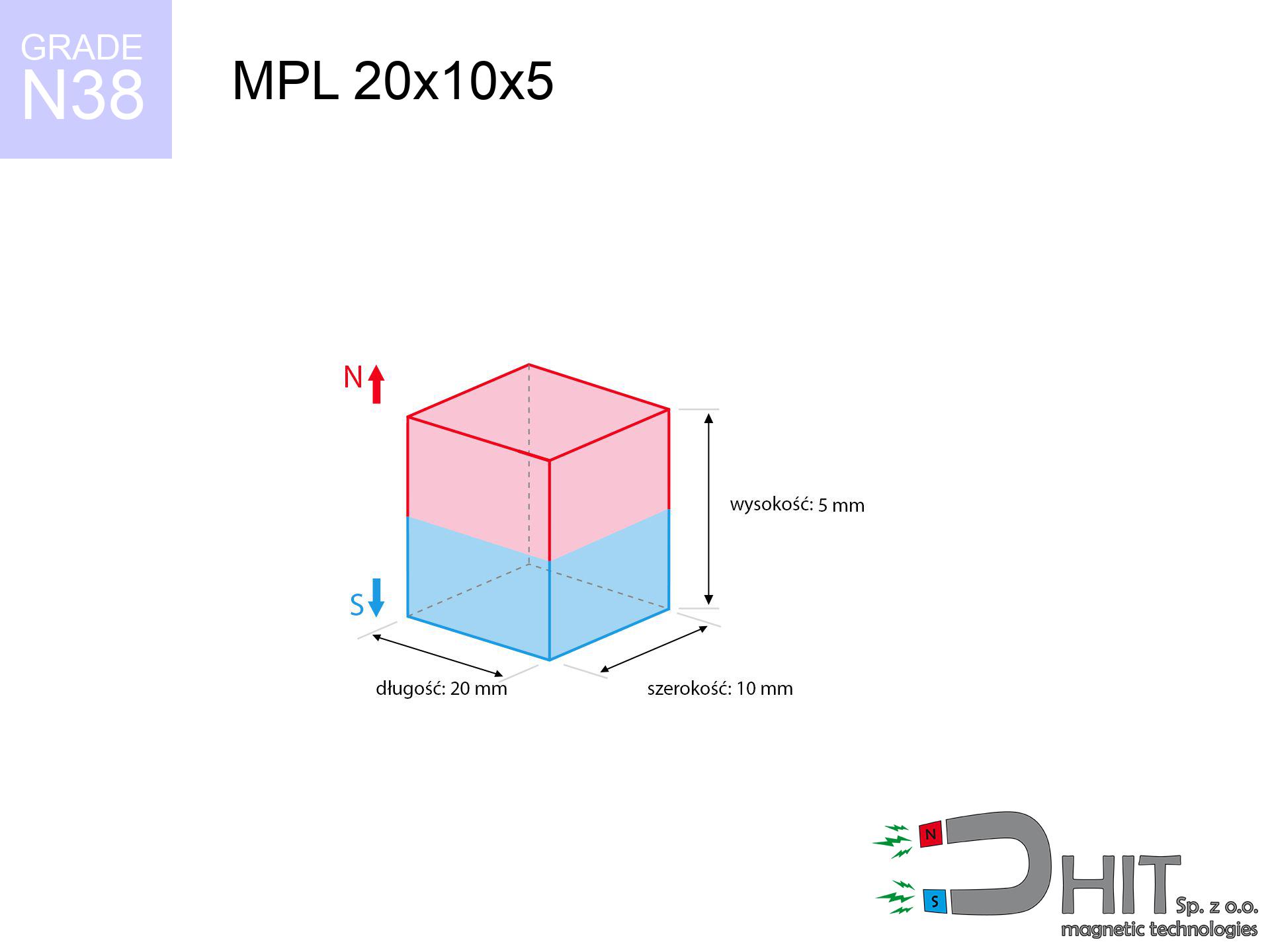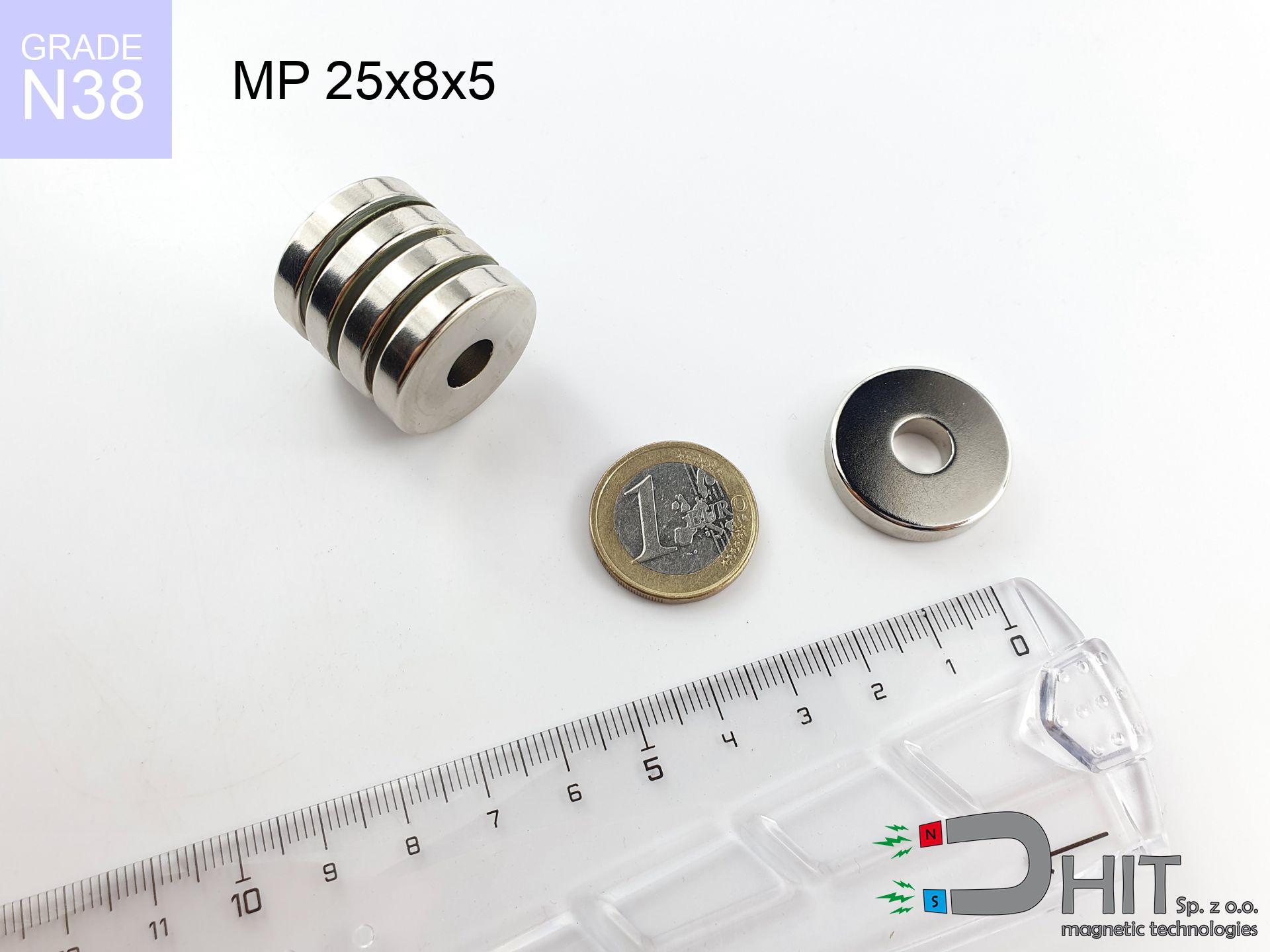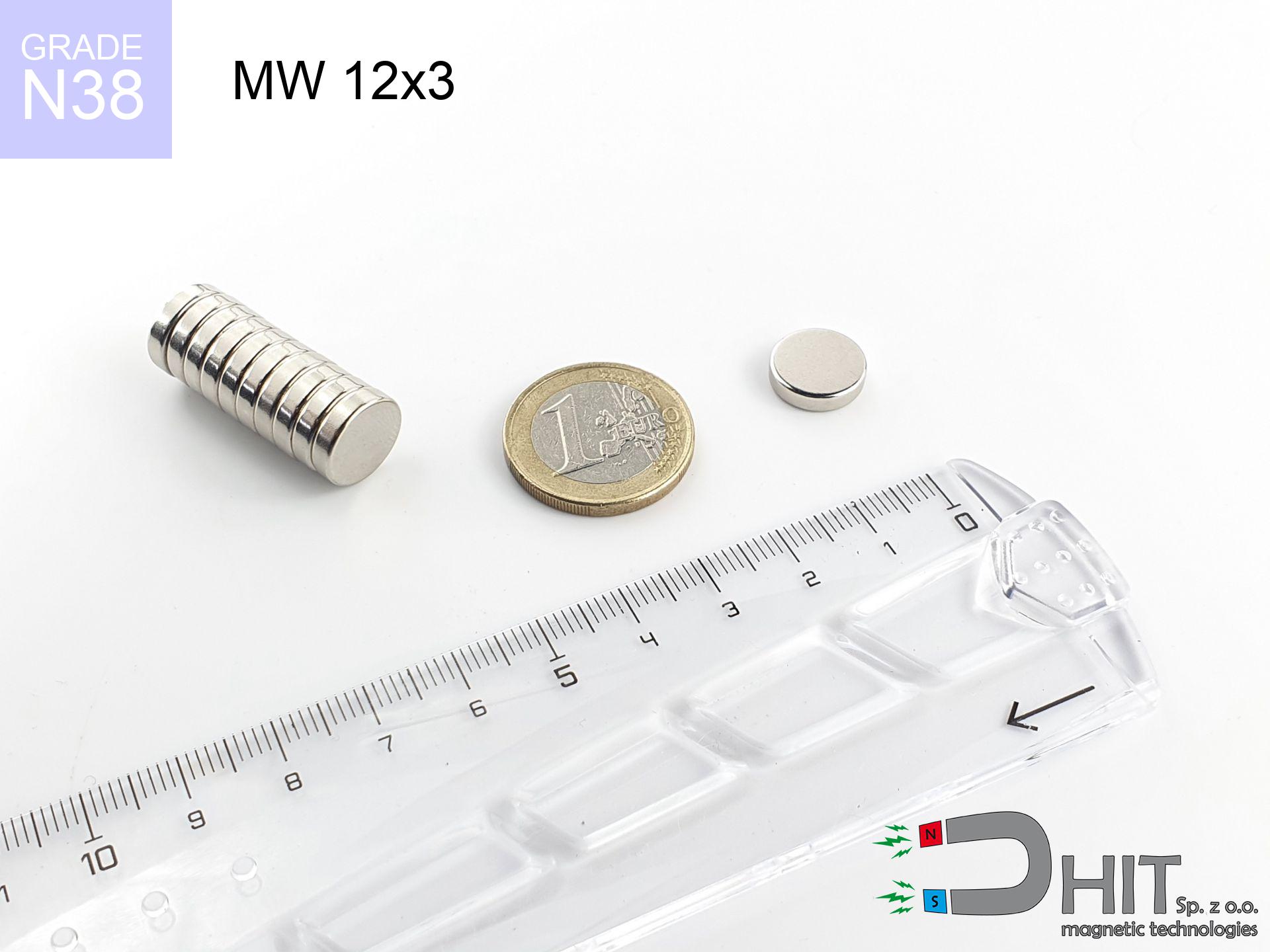MPL 20x10x5 / N38 - neodymium magnet
lamellar magnet
catalog number 020128
GTIN: 5906301811343
length
20
mm [±0,1 mm]
width
10
mm [±0,1 mm]
height
5
mm [±0,1 mm]
magnetizing direction
↑ axial
capacity ~
5.58 kg / 54.72 N
magnetic induction ~
349.47 mT / 3,495 Gs
max. temperature
≤ 80
°C
catalog number 020128
GTIN: 5906301811343
length
20 mm [±0,1 mm]
width
10 mm [±0,1 mm]
height
5 mm [±0,1 mm]
magnetizing direction
↑ axial
capacity ~
5.58 kg / 54.72 N
magnetic induction ~
349.47 mT / 3,495 Gs
max. temperature
≤ 80 °C
4.45 ZŁ gross price (including VAT) / pcs +
3.62 ZŁ net price + 23% VAT / pcs
bulk discounts:
need more quantity?Don't know what to choose?
Give us a call tel: +48 22 499 98 98 or write via form on the contact page. You can check the lifting capacity and the shape of neodymium magnets in our magnetic calculator power calculator
Orders placed by 2:00 PM will be shipped on the same business day.
Specification: lamellar magnet 20x10x5 / N38 ↑ axial
Magnetic properties of the material N38
Physical properties of sintered neodymium magnets Nd2Fe14B
Thanks to their mighty power, flat magnets are regularly applied in devices that require very strong attraction.
Most common temperature resistance of flat magnets is 80°C, but depending on the dimensions, this value can increase.
Moreover, flat magnets usually have different coatings applied to their surfaces, such as nickel, gold, or chrome, to increase their corrosion resistance.
The magnet labeled MPL 20x10x5 / N38 and a magnetic strength 5.58 kg weighing only 7.50 grams, making it the excellent choice for projects needing a flat magnet.
Contact surface: Thanks to their flat shape, flat magnets ensure a larger contact surface with other components, which is beneficial in applications requiring a stronger magnetic connection.
Technology applications: These magnets are often utilized in many devices, such as sensors, stepper motors, or speakers, where the thin and wide shape is important for their operation.
Mounting: Their flat shape makes it easier mounting, particularly when there's a need to attach the magnet to some surface.
Design flexibility: The flat shape of the magnets permits designers greater flexibility in placing them in structures, which can be more difficult with magnets of other shapes.
Stability: In some applications, the flat base of the flat magnet may offer better stability, minimizing the risk of sliding or rotating. However, it's important to note that the optimal shape of the magnet depends on the given use and requirements. In certain cases, other shapes, such as cylindrical or spherical, may be a better choice.
Magnets have two main poles: north (N) and south (S), which attract each other when they are oppositely oriented. Similar poles, such as two north poles, act repelling on each other.
Due to these properties, magnets are regularly used in electrical devices, such as motors, speakers, sensors, or magnetic locks. Neodymium magnets stand out with the greatest strength of attraction, making them indispensable for applications requiring powerful magnetic fields. Moreover, the strength of a magnet depends on its size and the materials used.
It should be noted that extremely high temperatures, above the Curie point, cause a loss of magnetic properties in the magnet. The Curie temperature is specific to each type of magnet, meaning that under such conditions, the magnet stops being magnetic. Additionally, strong magnets can interfere with the operation of devices, such as compasses, magnetic stripe cards or electronic devices sensitive to magnetic fields. For this reason, it is important to avoid placing magnets near such devices.
List recommended items
Advantages as well as disadvantages of neodymium magnets NdFeB.
Apart from immense strength, neodymium magnets have the following advantages:
- They do not lose their power (of the magnet). After about 10 years, their power decreases by only ~1% (theoretically),
- They protect against demagnetization caused by external magnetic sources extremely well,
- In other words, thanks to the shiny coating of nickel, gold, or silver, the element acquires an aesthetic appearance,
- They have very high magnetic induction on the surface of the magnet,
- Magnetic neodymium magnets are characterized by hugely high magnetic induction on the surface of the magnet and can operate (depending on the form) even at temperatures of 230°C or higher...
- The ability for precise shaping or customization to specific needs – neodymium magnets can be produced in a wide range of shapes and sizes, which amplifies their universality in usage.
- Significant importance in the industry of new technologies – are utilized in HDD drives, electric drive mechanisms, medical equipment and other advanced devices.
Disadvantages of neodymium magnets:
- They are prone to breaking as they are fragile when subjected to a strong impact. If the magnets are exposed to impacts, it is suggested using magnets in a protective case. The steel housing in the form of a holder protects the magnet from impacts and simultaneously increases its overall strength,
- Magnets lose their power due to exposure to high temperatures. In most cases, when the temperature exceeds 80°C, these magnets experience permanent loss in strength (although it is worth noting that this is dependent on the form and size of the magnet). To avoid this problem, we offer special magnets marked with the [AH] symbol, which exhibit high temperature resistance. They can operate even at temperatures as high as 230°C or more,
- They rust in a humid environment. For outdoor use, we recommend using waterproof magnets, such as those made of rubber or plastic,
- The use of a cover - a magnetic holder is recommended due to the limited production capabilities of creating threads or complex shapes in the magnet
- Health risk to health from tiny fragments of magnets can be dangerous, in case of ingestion, which is particularly important in the context of children's health. It's also worth noting that tiny parts of these magnets can complicate diagnosis in case of swallowing.
Precautions
Dust and powder from neodymium magnets are highly flammable.
Do not attempt to drill into neodymium magnets. Mechanical processing is also not recommended. If the magnet is crushed into fine powder or dust, it becomes highly flammable.
Neodymium magnets can become demagnetized at high temperatures.
Although magnets have shown to retain their effectiveness up to 80°C or 175°F, this temperature may vary depending on the type of material, shape, and intended use of the magnet.
Under no circumstances should neodymium magnets be placed near a computer HDD, TV, and wallet.
The strong magnetic field generated by neodymium magnets can damage magnetic media such as floppy disks, video tapes, HDDs, credit cards, magnetic ID cards, cassette tapes, or other devices. They can also destroy devices like video players, televisions, CRT computer monitors. Remember not to place neodymium magnets close to these electronic devices.
Under no circumstances should neodymium magnets be brought close to GPS and smartphones.
Magnetic fields can interfere with compasses and magnetometers used in aviation and maritime navigation, as well as internal compasses of smartphones and GPS devices. There are neodymium magnets in every smartphone, for example, in the microphone and speakers.
Neodymium magnetic are delicate as well as can easily crack and shatter.
Magnets made of neodymium are fragile and will crack if allowed to collide with each other, even from a distance of a few centimeters. Despite being made of metal and coated with a shiny nickel plating, they are not as hard as steel. At the moment of connection between the magnets, tiny sharp metal pieces can be propelled in various directions at high speed. Eye protection is recommended.
Magnets are not toys, youngest should not play with them.
Neodymium magnets are not toys. Do not allow children to play with them. In the case of swallowing multiple magnets simultaneously, they can attract to each other through the intestinal walls. In the worst case scenario, this can lead to death.
The magnet coating contains nickel, so be cautious if you have a nickel allergy.
Studies clearly indicate a small percentage of people who suffer from metal allergies such as nickel. An allergic reaction often manifests as skin redness and rash. If you have a nickel allergy, you can try wearing gloves or simply avoid direct contact with nickel-plated neodymium magnets.
Comparing neodymium magnets to ferrite magnets (found in speakers), they are 10 times more powerful, and their strength can surprise you.
To handle magnets properly, it is best to familiarize yourself with our information beforehand. This will help you avoid significant harm to your body and the magnets themselves.
Neodymium magnets are not recommended for people with pacemakers.
In the case of neodymium magnets, there is a strong magnetic field. As a result, it interferes with the operation of a heart pacemaker. However, if the magnetic field does not affect the device, it can damage its components or deactivate the device when it is in a magnetic field.
Neodymium Magnets can attract to each other, pinch the skin, and cause significant injuries.
Neodymium magnets will bounce and touch together within a distance of several to around 10 cm from each other.
To raise awareness of why neodymium magnets are so dangerous, read the article titled How very dangerous are strong neodymium magnets?.





![magnetic separator 32x225 [2xM8] / N42 magnetic separator 32x225 [2xM8] / N42](https://cdn3.dhit.pl/graphics/products/sm-32x225-2xm8-dob.jpg)

![badge holder 45x13x5 [M301] / N38 badge holder 45x13x5 [M301] / N38](https://cdn3.dhit.pl/graphics/products/ui45x13x5-m301-vud.jpg)

